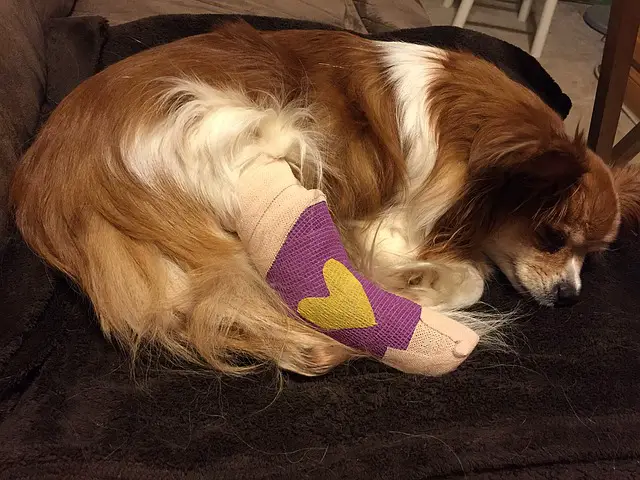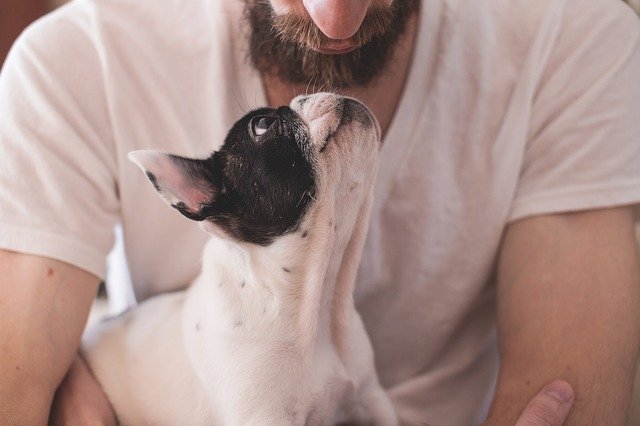
How much is ACL surgery for a dog? Well, the truth is it can be quite expensive beginning from $1500 to upwards of $4500. However, before you despair, there are a number of factors that affect how much you pay for your dog’s ACL surgery. These include the type of surgery, the location of the vet clinic, and a number of other factors. With the right information, you might be able to beat down the cost you spend on your dog’s ACL surgery.
First off, if your dog needs ACL surgery, we’re really sorry to hear that. We know how painful a torn cruciate ligament can be and how much despair you must be in seeing your dog in that much pain.
Table of Contents
What Is An ACL Surgery In Dogs?
First of all, more correctly, an ACL surgery is actually called a CCL surgery in dogs. You see, ACL stands for Anterior Cruciate Ligament which is what we humans have. It’s the connective tissue in the middle of each of our knees. Canines, on the other hand, also have this tissue. However, it’s called the Cranial Cruciate Ligament (CCL) in dogs. This CCL connects the femur to the tibia. The femur is the bone found above the knee while the tibia is found below the knee.
When this cruciate ligament is torn or ruptured, a cruciate surgery would be required to repair that ligament so your dog can walk normally again. This CCL procedure in dogs is similar to the ACL procedure in humans.
So, want to find out more about ACL surgery for dogs? Keep reading.
ACL (CCL) Surgery For A Dog
According to statistics, CCL surgery is the most common orthopedic procedure carried out on dogs. In fact, it makes up 85% of all orthopedic surgeries carried out on dogs every year.
Because cruciate injuries are so common, experts have developed several kinds of techniques for carrying out CCL surgeries. Each of these techniques have their advantages and disadvantages, of course.
It is important, therefore, to discuss all the different techniques with your vet and confirm as well as their advantages and disadvantages. This way you can decide on what technique is best for your dog.
The factors you might want to consider when choosing an ACL procedure for your dog include the dog’s weight, age, size, as well as his lifestyle. The preference of your surgeon would also have to be considered too, not forgetting the cost of the procedure as well.
Check out this video for an overview of what an ACL (or more correctly, CCL) tear in dogs is as well as the surgical procedures involved in the repair of this torn ligament.
There are different methods of performing an ACL surgery on a dog and the cost of these methods vary, depending on the nature of the procedure. The experience and qualification of the surgeon will also matter as well as your geographical location.
Now, because health care for pets is not regulated as it is for humans, you can find that the cost of health care for your pets in urban areas can be double what it is in rural areas.
The cost of a veterinary ACL surgery fluctuates a lot. However, an understanding of the nature of the different methods can help you understand and appreciate the difference in cost across methods. Sadly, depending on where you live, these differences in ACL surgery procedures can add literally thousands of dollars to your bill.
In the end, choosing an ACL surgery procedure for your dog will depend on the one that’s best suited for your dog’s needs as well as your budget.
What Are The Types Of ACL Surgeries For Dogs?
There are four primary types of surgical procedures for ACL surgeries in dogs, namely:
- Lateral Suture Technique also called Extracapsular Repair.
- Tibial Plateau Leveling Osteotomy (TPLO).
- Tibial Tuberosity Advancement (TTA).
- Tight Rope Technique.
What Is A Lateral Suture Technique (Extracapsular Repair)?
The lateral suture technique (extracapsular repair) is one of the oldest ACL surgery procedures carried out on dogs and is generally considered the traditional method of ACL surgery in dogs. The purpose of this surgery is to make the hind joint regain its stability by putting the sutures outside of the joint. Doing this will mimic the action of a ligament and help the dog walk more stably.
In doing this, the surgeon places a continuous monofilament nylon suture around the femur’s fabella and then loops through a hole already drilled into the tibial tuberosity. When that is done, the surgeon ties the ends of the fishing-line-like sutures in place using a stainless steel clip.
Recovery after this procedure takes about 12 weeks within which your dog will require intensive care and confinement. The American Association of Veterinary Surgeons claims that this surgical procedure has a 90% success rate, so your dog’s chances are definitely good with this surgery.
The most common complication with this surgery is an infection of the incision point. So, as the owner, you’re going to have to be attentive to the cleaning and icing of the site of incision regularly.
Also, ensure that your dog constantly wears his Elizabethan collar so that he won’t lick on the affected area and aggravate the injury.
What Is A Tibial Plateau Leveling Osteotomy (TPLO)?
In a tibial plateau leveling osteotomy procedure, the injured knee is restructured to a large extent. It was developed by Dr. Barclay Slocum, and at first, was considered quite radical. However, as the years passed, the surgery became increasingly popular and is still in use till today.
This procedure changes the grade and angle of the knee altogether, so some experts believe that it addresses the underlying problem of a ruptured ACL joint.
If you look at a dog whose CCL is ruptured from the side, it usually looks like the hind knee is perpetually bent. Even while just standing, these dogs appear to be bearing weight on their knee.
In the TPLO procedure, the surgeon relieves the ligaments of the surrounding joint of that pressure by changing the angle of the knee altogether.
So, they cut the tibial plateau and rotate it so that the slope changes. When this rotation is done, the knee is relieved of the pressure of weight-bearing for a prolonged time.
It’s a more in-depth approach than the first method we discussed — the Lateral Suture Technique. However, it takes less time for recovery. Post-operative care only takes about 12 weeks. However, within these 12 weeks, physical therapy must be carried out to enable your dog adjust to the new angle of their knee.
What Is Tibial Tuberosity Advancement (TTA)?
The Tibial Tuberosity Advancement (TTA) procedure is a different kind of procedure from other ACL surgery techniques. This procedure does not affect the ligament attached to the knee joint at all. Instead, the procedure changes the structure of the bone such that it no longer requires the ligament for stabilization.
So, the surgeon makes a linear incision along the front line of the tibia. The cut tibia is then moved forward and the surgeon then places a bone spacer in the now opened space between the tibial tuberosity and the tibia. Afterward, the surgeon places a metal plate made of stainless steel to stabilize the bone. When this is done, the femur will no longer slide forward and there won’t be need for a cranial cruciate ligament anymore, intact or not.
For this procedure, post-operative care is very crucial. You must be ready to make several lifestyle changes in order to accommodate the effects of this invasive surgery on your dog.
Expect a post-op recovery time of up to twelve months. However, the first four weeks after the procedure will be the most crucial and the most intense.
What Is Tight Rope Technique In ACL Surgery?
The tight rope technique is one of the most recent ACL surgery methods for dogs, developed in the year 2007. The procedure was first attempted by a group of vet surgeons at the University of Missouri Veterinary College. Since then, this procedure has increased in popularity and is a much less expensive procedure than TTA surgery or TPLO surgery.
It’s a slight modification of a human ACL procedure for treating tears in the ligaments of the ankle. The surgeon drills small holes into the bone at the knee joint to create what is called bone tunnels. After this, the tunnels are branded with Fibertape. Fibertape is practically indestructible and threads the knee both in lateral and vertical directions.
Tightrope surgery is the least invasive and the most cost-effective ACL surgery for dogs you could possibly consider.
However, this procedure can only be carried out on dogs that are, at least, 40 pounds or heavier. Dogs who have had a stainless steel metal plate placed in their knee joint from past surgeries, regardless of size, cannot undergo the tightrope surgical procedure.
During recovery, you’d have to emphasize physical therapy to your dog. If you won’t be available or able to assist your dog with his mobility exercises, then you should probably opt for a different kind of surgery.
Watch the video below to learn more about tightrope surgery for ACL tear in dogs.
Now that you know the four kinds of surgeries available to you for ACL repair in dogs, it’s time to discuss with your vet surgeon. Remember that you’d need to keep the age, weight, size, and nature of your dog’s knee injury in mind when deciding what kind of procedure to go for.
Also, remember that the cost of the procedure will also affect what you opt for in the end as you have to consider your budget as well. If the really invasive surgeries are too expensive, then you can opt for a less invasive and more cost-effective option.
How Much Is ACL Surgery For A Dog?

Determining how much ACL surgery will cost for your dog is dependent on a lot of variables. Your geographical location, the procedure type, the medication involved, as well as the physical therapy requirements will all affect how much the surgical procedure will cost the dog owner.
But remember that it doesn’t end at the surgery. You’d also have to prepare your home for confinement and other necessary adjustments in order to make it conducive for the post-operative care requirements.
Also, if you decide to go for a specialized vet surgeon, you can be sure that the cost of the surgery will go up significantly.
Another thing you might want to consider is that you might have to take some time off work in order to be there for your dog. Even if you can’t, you might have to hire a sitter to care for your dog and that will also cost you some cash.
In the United States, vet hospitals in the metropolitan cities will cost you about twice what you’d spend in smaller towns.
Cities like Boston, New York, Washington DC, Los Angeles, Seattle, and San Francisco have about the highest fees when it comes to ACL injuries in dogs.
Why these prices vary so widely from urban to rural areas is as a result of a number of factors.
For one, the cost of real estate in urban areas is much higher than in rural areas. Secondly, urban areas have a higher population and, therefore, a higher demand which, according to the laws of economics affects fees as well. Lastly, urban areas attract the more qualified and more experienced vet surgeons, partly because they get paid better.
Cost Of ACL Surgery For A Dog In Different Cities
The cost for ACL surgery for a dog in the regions mentioned below is taken from a specific vet clinic with a vet surgeon of, at least, 10 years experience. Costs might differ. However, generally, the cost of this surgery in these regions will fall within this price range.
How Much Does ACL Surgery For Dogs Cost In New York City?
These are the average costs for ACL surgery for dogs in New York
- TLPO: About $6350
- TTA: About $4800
- Lateral suture: About $995.
- Tightrope: About $650
TPLO Surgery
This typically costs about $6350 dollars and the cost includes anesthesia, pre-operative and post-operative x-rays, four post-operative home visits, as well as an initial physical therapy session.
TTA Surgery
This costs about $4800 including anesthesia, pre-operative and post-operative x-rays, four post-operative visits, as well as an initial physical therapy session.
Lateral Suture Technique
This one is much cheaper costing about $995 — an all-inclusive deal.
Tightrope Surgery
This costs about $650 in New York. It’s the most cost-effective as we have said.
However, small dogs can’t undergo this procedure same as dogs who have undergone ACL surgery before. Please, note that this cost will not cover physical therapy which is a critical aspect of post-operative care for this procedure.
How Much Does ACL Surgery For Dogs Cost In Orange County, California?
This is how much ACL surgeries for dogs cost in Orange County, California:
- TPLO: About $4300.
- TTA: About $3700.
- Lateral suture: About $1000.
- Tightrope: About $850.
TPLO Surgery
This costs about $4300. Usually, this cost will include pre-operative and post-operative X-rays, two visits at home post-surgery, but does not include physical therapy.
You might also have to pay about $200 for an initial consultation and then another $100 for follow-up therapy in most clinics in this area.
TTA Surgery
This is a less expensive procedure at about $3700. Like the TPLO surgery, TTA surgery in this region will cover all surgery-related requirements besides physical therapy.
Lateral Suture Surgery
This comes as an all-inclusive cost of about $1000.
Tightrope Surgery
As usual, this is the most affordable technique at about $850. This fee contains everything needed for the surgery besides physical therapy.
How Much Does ACL Surgery For Dogs Cost In Whitehall, Wisconsin?
These are the average costs of ACL surgeries for dogs in Whitehall, Wisconsin:
- TPLO: $3300.
- TTA: $2600.
- Lateral suture: $850.
- Tightrope: About $750.
TPLO Surgery
This surgery costs about $3300. However, this fee does not include physical therapy as well as post-operative care costs. Every other cost concerning surgery is included in this fee.
TTA Surgery
This falls within the range of about $2600. Just like TPLO, physical fees and post-operative costs are not included here just surgical costs.
Lateral Suture Surgery
This costs about $850 but does not include post-operative fees or physical therapy.
Tightrope Surgery
This goes for about $750. It includes both physical therapy and treatment.

How Much Does ACL Surgery For Dogs Cost In Scottsdale, Arizona?
These are the average costs of ACL surgeries for dogs in Scottsdale, Arizona:
- TPLO: $4400.
- TTA: $3600.
- Lateral suture: $995.
- Tightrope: $850.
TPLO Surgery
This should cost about $4400 including all aspects of surgery but no post-operative care.
TTA Surgery
This costs about $3600 without any post-operative care.
Lateral Suture Surgery
This goes for about $995, an all-inclusive package including follow-up appointments but not including physical therapy.
Tightrope Surgery
Costing about $850, this fee will cover pre-operative and post-operative care. However, it won’t include post-surgical physical therapy.
How Much Does ACL Surgery For Dogs Cost In Charleston, South Carolina?
These are the average costs for ACL surgery for dogs in Charleston, South Carolina:
- TPLO: About $3500
- TTA: About $2000
- Lateral suture: About $895.
TPLO Surgery
Usually, this could cost between $3250 and $3700 including all the necessary x-rays and checkups.
TTA Surgery
This will cost you about $2000 just for surgery. Other fees associated with the surgical procedure are not included in $2000 for the surgery.
Lateral Suture Surgery
This should cost about $895, an all-inclusive deal including x-rays and post-operative lab work. This cost does not include physical therapy.
Veterinary Insurance For ACL Surgery In Dogs

Having insurance for your pet is a huge advantage for dogs and dog owners as the insurance can help to cover a huge portion of your fees. In most cases, with pet insurance, you might end up paying only about 10% of the surgery.
Nonetheless, you might have to bear the cost of physical therapy alone. Depending on the pet insurance company though, your insurance might also be able to cover a small part of physical therapy fees as well.
Check out these other helpful articles:
- Fashion&Cool LED Dog Collar — in-depth review.
- Max and Neo Martingale Collar — detailed review.
- Blue Buffalo Rocky Mountain Weight Loss Dog Food — detailed review.
- Carlson Secure and Foldable Dog Crate — in-depth review.
- PetSafe KeepSafe Break Away Collar — in-depth review.
- New World Folding Metal Dog Crate — in-depth review.
What Alternative Care Methods To ACL Surgery In Dogs?
If the cost of ACL surgery for a dog is way beyond your budget, there might be other ways for you to take care of your dog’s torn cruciate ligament besides surgery, especially if he weighs less than 40 pounds. One main method is prolotherapy, however, some other methods include:
- Using a knee brace.
- Confinement and limited activity.
- Acupuncture.
- Ice therapy.
- A massage.
- Vitamin supplements (like turmeric, glucosamine, and fish oil).
- Swimming.
Especially if your dog weighs less than 40 pounds, your dog can recover fully from a ruptured ligament with the use of a knee brace, confinement, limited activity, acupuncture, ice therapy, a massage, vitamins, supplements (including turmeric, glucosamine, and fish oil), swimming, and other treatments.
Typically, surgery produces results much faster. However, if your budget won’t let you, then you can use the care process mentioned above known as conservation management.
You can get a non-rigid bracewhich can help to stabilize the knee joint. It’s great for handling sprains, strains, and other CCL injuries of the knee.
Here is a video of a dog treated with conservation management for his torn CCL.
What Is Prolotherapy?
Prolotherapy is a method that could help you by-pass surgery if you can’t afford the costs at the time. Also known as proliferation therapy or regenerative injection therapy, this method involves the veterinarian injecting an irritant solution into the affected ligament or tendon. When injected, this irritant solution will help to stimulate the healing of the tear in the ligament and relieve pain as well.
Watch as Dr. Marc Smith carries out this procedure in the video below:
Complications Of ACL Surgery In Dogs
The American College of Veterinary Surgeons (AVCS) says the prognosis of ACL surgery in dogs is quite good. Dogs who have had to undergo a surgical repair of their torn cruciate ligament show observable improvement 95 to 90% of the time.
However, like all surgical procedures, even ACL surgeries in dogs come with complications. The most common complications with ACL surgery in dogs include infection, implant failure, as well as a lack of stabilization.
Things worsen if your dog has osteoarthritis. Osteoarthritis is a common complication that occurs with the tearing of the cranial cruciate ligament in dogs. Once this occurs, with or without surgery, the condition progresses and gradually worsens. However, a surgical procedure can slow things down a bit.
Please note that arthritis is progressive in nature and develops faster in stiff, injured joints. You should, therefore, consider preventing and managing arthritis in your dog once he has any ACL surgery procedure.
What Dogs Are More Prone To Tearing Their Cruciate Ligament?

Dog breeds that are particularly prone to tearing their cranial cruciate ligament include:
- Newfoundland.
- Akita.
- Chesapeake Bay Retriever.
- Labrador Retriever.
- Staffordshire Bull Terrier.
- Neopolitan Mastiff.
- Saint Bernard.
Now, for most cases, it’s senior dogs who often come down with cases of torn cruciate ligaments. Nonetheless, sometimes, younger dogs can sometimes also come down with torn cranial cruciate ligament.
The precise cause of a torn cruciate ligament in dogs is unknown. However, it is believed that genetics play a role in this case. Some experts also believe that neutering or spaying your dog at a really young age can contribute to this since the dog gets bigger than normal.
(Learn more about neutering and spaying in our article: How To Neuter A Dog At Home).
If your dog has suffered knee injuries before such as patellar luxation, or any trauma in the knee, he is more likely to suffer a torn cruciate ligament at some point.
What Are The Symptoms Of ACL Injury In Dogs?
One way you can tell your dog has a torn CCL is when he begins to show signs of lameness. Limping begins and gradually gets worse as the dog begins to favor the non-injured leg.
Now, as the dog begins to use the injured knee less and less, favoring the non-injured knee, he puts pressure on that knee (the non-injured one). This is the reason that, oftentimes, an ACL injury on one knee eventually leads to an injury on the other knee about 60% of the time.
For dogs, a CCL tear would typically begin little by little and then worsen over time. Physical activity brings the initial small tear into a full-blown tear. You know, dogs can hardly resist engaging in quick, sudden movements which only aggravates an already torn CCL.
How Can You Prevent ACL Tears In Dogs?
It can be quite difficult to prevent ACL tears in dogs because this usually occurs during activity. Of course, you can’t exactly keep your dog from engaging in activity in order to keep him from tearing his cranial cruciate ligament. This will put your pet in all kinds of health risks.
One thing you can do, though, is to delay neutering or spaying until your dog is, at least, two years old. This will help to mitigate the risk of suffering a torn cruciate ligament later in life. Vets, on the other hand, warn against delaying neutering or spaying as it could lead to the breeding of unwanted puppies.
Breeders can also help to prevent ACL tears in dogs by stopping the breeding of dogs who show a genetic predisposition to torn cruciate ligaments repeatedly.
Preventing torn cruciate ligaments in dogs does not end here though. According to statistics, 50% of dogs who tear one cruciate ligament will tear the other one on the opposite side sometime in future. In fact, from practice, experts have seen this figure to be closer to 70% in most cases.
The reason for this other injury is mostl.y due to the overuse of the good knee.
However, you can prevent this by engaging in physical therapy for the operated leg, hormone supplementation can also help, as well as vitamin and mineral supplements to aid the formation of collagen.
How Much Is ACL Surgery For A Dog? — Related FAQs
How Successful Is ACL Surgery In Dogs?
The success rate for ACL surgery in dogs is quite high: 85 to 90%. Hence, for most dogs, within two to four months after surgery, they would be back to normal life.
Nonetheless, there are some dogs that do not make it after ACL surgery no matter how well they are taken care of.
Can A Dog Live Comfortably With A Torn ACL?
A dog cannot live comfortably with a torn ACL. ACL injuries are painful and cause lameness in dogs. This lameness gradually gets worse as the dog begins to favor the other limb in a bid to relieve pain. Sadly, the more he leans on the other limb, the more that limb gets weaker. This would eventually lead to rupturing and possibly another torn CCL.
Can A Dog Recover From A Torn ACL Without Surgery?
However, especially with small breeds, a torn ACL will heal itself within three to six weeks if left untreated.
Nonetheless, an unhealthy CCL would lead to bones rubbing off on each other. This would eventually cause other complications such as pain, bone spurs, arthritis, as well as a decrease in the range of movements for that particular limb.
How Long Is Recovery For Dog ACL Surgery?
Recovery from ACL surgery for dogs takes between two to five months. During this period, you must keep your dog from strenuous activity and aggressive playing until after the 4-month mark.
Simply continue the physiotherapy exercises recommended at the vet clinic, increasing the level of activity as your dog’s knee begins to improve and return to normal function.
Do Dogs Stay Overnight After ACL Surgery?
Most times, your dog would be required to stay overnight at the vet clinic after an ACL surgery for observation. While in observation after the surgery, your vet will place your dog on general anesthesia and also administer some painkillers and antibiotics as well.
Does My Dog Really Need ACL Surgery?
Dogs with a torn CCL need surgery to stabilize the joint and to reduce their chances of developing arthritis later in the future.
Surgery is also important to prevent the other limb from developing injuries or even another CCL tear due to overexertion. If both legs suffer CCL tears, life would become tremendously difficult for your dog as mundane tasks such as walking and squatting, rising would become excruciating.



